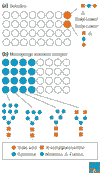Glycan arrays for functional glycomics
- PMID: 12537579
- PMCID: PMC151192
- DOI: 10.1186/gb-2002-3-12-reviews1034
Glycan arrays for functional glycomics
Abstract
Interactions between carbohydrates and proteins mediate intracellular traffic, cell adhesion, cell recognition and immune system function. Two recent papers describe how arrays of oligosaccharide and polysaccharide molecules can be used to investigate these interactions more fully.
Figures


Similar articles
-
Glycobiology in the cytosol: the bitter side of a sweet world.Biochim Biophys Acta. 2009 Feb;1790(2):81-94. doi: 10.1016/j.bbagen.2008.09.009. Epub 2008 Oct 8. Biochim Biophys Acta. 2009. PMID: 18952151 Review.
-
Endomembrane traffic and targeting in plant cells.Curr Opin Cell Biol. 1990 Aug;2(4):673-80. doi: 10.1016/0955-0674(90)90109-r. Curr Opin Cell Biol. 1990. PMID: 2252592 Review. No abstract available.
-
The role of plant cell wall polysaccharide composition in disease resistance.Trends Plant Sci. 2004 Apr;9(4):203-9. doi: 10.1016/j.tplants.2004.02.005. Trends Plant Sci. 2004. PMID: 15063871 Review.
-
Expression cloning of proteins on membrane traffic pathways.Biochem Soc Trans. 1990 Apr;18(2):148-9. doi: 10.1042/bst0180148. Biochem Soc Trans. 1990. PMID: 2379672 No abstract available.
-
Glycomics-driven discoveries in schistosome research.Exp Parasitol. 2007 Nov;117(3):275-83. doi: 10.1016/j.exppara.2007.06.003. Epub 2007 Jun 17. Exp Parasitol. 2007. PMID: 17659278 Review.
Cited by
-
Quantifiable fluorescent glycan microarrays.Glycoconj J. 2008 Jan;25(1):15-25. doi: 10.1007/s10719-007-9066-8. Epub 2007 Sep 1. Glycoconj J. 2008. PMID: 17763939
-
Haemolytic actinoporins interact with carbohydrates using their lipid-binding module.Philos Trans R Soc Lond B Biol Sci. 2017 Aug 5;372(1726):20160216. doi: 10.1098/rstb.2016.0216. Philos Trans R Soc Lond B Biol Sci. 2017. PMID: 28630155 Free PMC article.
-
Carbohydrate microarrays.Chem Soc Rev. 2013 May 21;42(10):4310-26. doi: 10.1039/c2cs35401b. Epub 2012 Nov 28. Chem Soc Rev. 2013. PMID: 23192235 Free PMC article. Review.
-
Defined Glycan Ligands for Detecting Rare l-Sugar-Binding Proteins.J Am Chem Soc. 2025 Apr 9;147(14):11693-11699. doi: 10.1021/jacs.5c03251. Epub 2025 Apr 1. J Am Chem Soc. 2025. PMID: 40167164 Free PMC article.
-
Are glycan biosensors an alternative to glycan microarrays?Anal Methods. 2014 Sep 7;6(17):6610-6620. doi: 10.1039/C4AY00692E. Epub 2014 Jul 9. Anal Methods. 2014. PMID: 27231487 Free PMC article.
References
-
- Taylor ME, Drickamer K. Introduction to Glycobiology. New York: Oxford University Press; 2002.
-
- Wang D, Liu S, Trummer BJ, Deng C, Wang A. Carbohydrate microarrays for the recognition of cross-reactive molecular markers of microbes and host cells. Nat Biotechnol. 2002;20:275–281. - PubMed
-
- Fukui S, Feizi T, Galustian C, Lawson AM, Chai W. Oligosaccharide microarrays for high-throughput detection and specificity assignments of carbohydrate-protein interactions. Nat Biotechnol. 2002;20:1011–1017. - PubMed
-
- Feizi T, Stoll MS, Yuen C-T, Chai W, Lawson AM. Neoglycolipids: probes of oligosaccharide structure, antigenicity and function. Methods Enzymol. 1994;230:484–519. - PubMed
-
- GlycoSuiteDB http://www.glycosuite.com/
Publication types
MeSH terms
Substances
LinkOut - more resources
Full Text Sources

